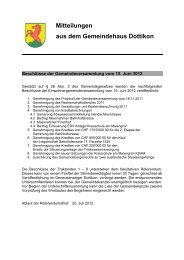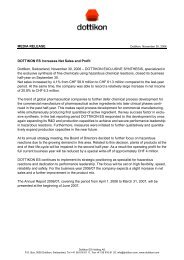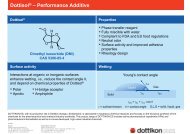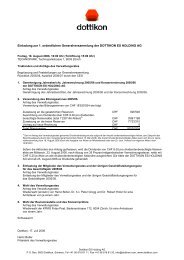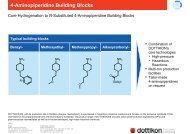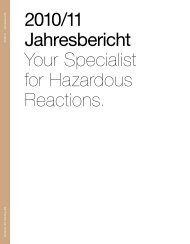pdf file - Dottikon
pdf file - Dottikon
pdf file - Dottikon
You also want an ePaper? Increase the reach of your titles
YUMPU automatically turns print PDFs into web optimized ePapers that Google loves.
42 Notes DOTTIKON ES Group Annual Report 2011/12<br />
Employee benefits<br />
The pension plans of DOTTIKON ES Group are classified as<br />
defined benefit plans in accordance with IFRS. For the purposes<br />
of the consolidated financial statements, future pension<br />
obligations are calculated based on actuarial methods in accordance<br />
with IFRS. Assumptions are made to estimate future<br />
developments. These include the assumptions and estimates<br />
regarding the discount rate, the expected long-term return on<br />
plan assets, the estimates of remuneration growth, and retirement<br />
income adjustments. The actuarial calculations for<br />
determining the defined benefit obligation are also based on<br />
statistical information such as life expectancy and future withdrawals<br />
of participants from the plan. Whenever these parameters<br />
used change due to changes in market and economic<br />
conditions, the actual results can differ significantly from the<br />
actuarial calculation and valuation. These differences can<br />
impact the pension assets and liabilities as well as expenses<br />
and income from pension plans significantly on a medium<br />
term. The carrying amount of the recognized plan assets is<br />
presented in notes 12 "Employee Benefits".<br />
Income taxes<br />
The measurement of current income taxes and deferred taxes<br />
requires comprehensive considerations such as the interpretation<br />
of local tax legislation. IFRS requires an entity to account<br />
for the tax consequences of the transactions and other events<br />
for which the final assessment of taxes does not occur in the<br />
reporting period. As the result of the final assessment can vary<br />
from the calculation performed during the reporting period,<br />
the income taxes for the current period can be subject to<br />
significant adjustments. Furthermore, in order to determine<br />
whether tax loss carryforwards may be carried as an asset, it<br />
is first necessary to critically assess the probability that there<br />
will be future taxable profits against which to offset them. This<br />
assessment depends on a variety of influencing factors and<br />
developments.<br />
43 Notes DOTTIKON ES Group Annual Report 2011/12<br />
STANDARDS AND INTERPRETATIONS THAT HAVE<br />
BEEN ISSUED BUT NOT YET APPLIED<br />
The following new and revised standards and interpretations<br />
have been issued up to the date the Board of Directors has<br />
approved these consolidated financial statements, but are not<br />
yet effective and are not applied early in these consolidated<br />
financial statements. Their impact on the consolidated financial<br />
statements of DOTTIKON ES Group has not yet been<br />
systematically analyzed. The expected effects as disclosed<br />
below the table reflect a first assessment by management of<br />
the Group.<br />
Standard/Interpretation Effective date<br />
Planned application by<br />
DOTTIKON ES Group<br />
Amendments to IFRS 7 – Disclosures – Transfers of Financial Assets C July 1, 2011 Business year 2012/13<br />
Amendments to IAS 12 – Deferred Tax: Recovery of Underlying Assets C January 1, 2012 Business year 2012/13<br />
Amendments to IAS 1 – Presentation of Items of Other Comprehensive Income B July 1, 2012 Business year 2013/14<br />
Amendments to IFRS 7 – Disclosures – Offsetting Financial Assets and Financial Liabilities B January 1, 2013 Business year 2013/14<br />
IFRS 10 – Consolidated Financial Statements C January 1, 2013 Business year 2013/14<br />
IFRS 11 – Joint Arrangements C January 1, 2013 Business year 2013/14<br />
IFRS 12 – Disclosure of Interests in Other Entities B January 1, 2013 Business year 2013/14<br />
IFRS 13 – Fair Value Measurement C January 1, 2013 Business year 2013/14<br />
IAS 19 revised – Employee Benefits D January 1, 2013 Business year 2013/14<br />
Amendments to IAS 27 – Separate Financial Statements A January 1, 2013 Business year 2013/14<br />
Amendments to IAS 28 – Investments in Associates and Joint Ventures A January 1, 2013 Business year 2013/14<br />
IFRIC 20 – Stripping Costs in the Production Phase of a Surface Mine A January 1, 2013 Business year 2013/14<br />
Amendments to IAS 32 – Offsetting Financial Assets and Financial Liabilities B January 1, 2014 Business year 2014/15<br />
IFRS 9 – Financial Instruments C January 1, 2015 Business year 2015/16<br />
A<br />
No impact or no significant impact is expected on the consolidated financial statements of DOTTIKON ES Group<br />
B<br />
The impact on the consolidated financial statements of DOTTIKON ES Group is expected to result in additional disclosures or changes in presentation<br />
C<br />
The impact on the consolidated financial statements of DOTTIKON ES Group cannot yet be determined with sufficient reliability<br />
D<br />
IAS 19 revised "Employee Benefits" is effective for annual periods beginning on or after January 1, 2013. According to their analysis, management expects the following<br />
impacts on the consolidated financial statements:<br />
■ Actuarial gains and losses will have to be recognized within other comprehensive income. The option of deferred recognition according to the corridor method is no<br />
longer allowed. DOTTIKON ES Group already recognizes actuarial gains and losses within other comprehensive income<br />
■ The return on plan assets is no longer estimated on the expected return on plan assets based on asset allocation, but the return is instead recognized by the amount of<br />
the discount rate. Due to the new regulation, net defined benefit expenses of the reporting year 2011/12 would have been increased by additional CHF 800 thousand<br />
(opposite effect within other comprehensive income)



